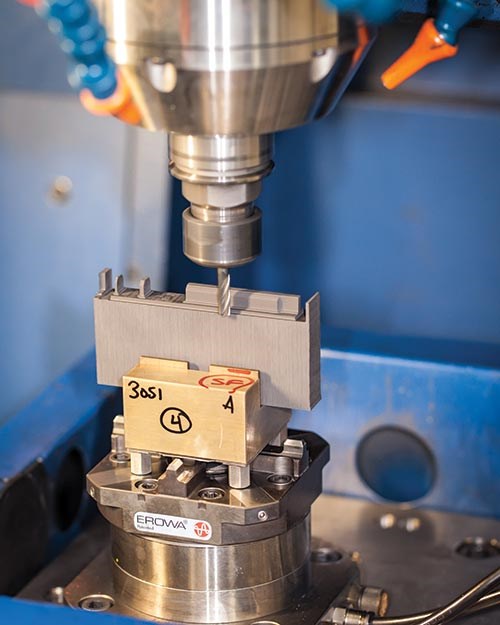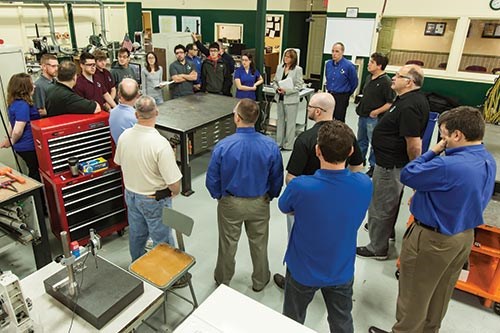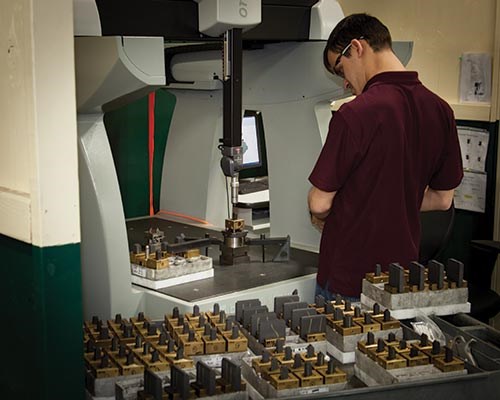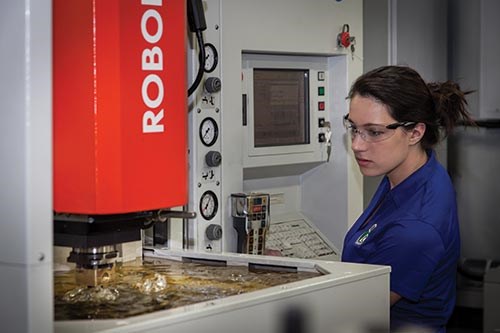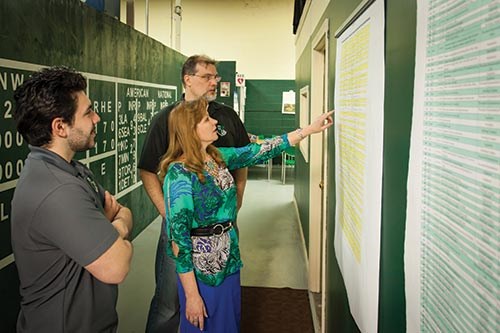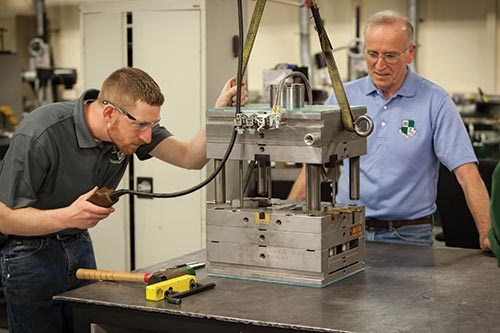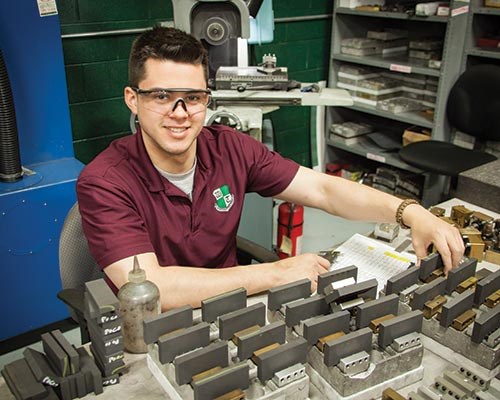2014 Leadtime Leader Awards Winner: Westminster Tool Inc.—Bridging the Gap without Losing Focus
Appears in Print as: '2014 Leadtime Leader Awards Winner: Westminster Tool Inc.—Bridging the Gap without Losing Focus'
A strong sense of self and a focus on people enabled this mold manufacturer to rapidly expand pre- and post-manufacturing services without getting overwhelmed by its own growth.
#leadtimeleader
Of all the shops considered for the 2014 Leadtime Leader Award, Westminster Tool Inc. didn’t have the shortest lead times. It didn’t have the shortest delivery times, either. What did stand out was just how far this Plainfield, Connecticut, mold manufacturer has come in such a short amount of time. In the past 36 months alone, the company has reduced average lead times by 15 percent and improved its on-time delivery rate by more than 20 percent.
Just as notable is the fact that Westminster has achieved these gains while shipping more product than ever before, as evidenced by a 60-percent increase in sales during that same 36 months. Moreover, individual jobs are far more involved than in the past. That’s primarily because of a drive to “bridge the gap” between concept and production—the shop’s own phrasing for a business philosophy that it formally codified about four years ago. As a result of this drive, the company has moved from focusing solely on toolmaking to providing such pre- and post-manufacturing services as mold flow and CAE analysis; manufacturability insight; mold validation; process failure mode and effect analysis (PFMEA); and pre-production molding; among others.
Featured Content
How has Westminster managed all this without getting overwhelmed by its own rapid growth? That was the subject of a recent series of conversations with Ray Coombs, founder and president, and Mark Ypsilantis, VP of Business Development and Marketing. These conversations revealed that much of the company’s success stems from a deep awareness of its own capabilities and limitations. Recognizing that few businesses can be all things to all customers, Westminster has developed its increasingly comprehensive service offering to serve a specific market niche. That way, the shop can expand without losing focus on core competencies. Self insight is just as important for forming strategic outside partnerships that help support a broader set of capabilities.
Most important of all is Westminster’s recognition that its chief competitive advantage is its people. The result is a bottom-up approach that leverages the skills of all 32 employees to keep the company on the move. From front office to shop floor, constantly seeking ways to do things better is part of the job description. A steady influx of apprentices and interns keeps ideas fresh, although veterans and new hires alike are constantly learning—and often teaching. All training is based on standardized methods that provide consistency and efficiency throughout the organization. Cross training is particularly important for providing the versatility to cope with market upswings and downswings, not to mention opportunities for advancement and even time off. Turnover is almost negligible.
Targeted Growth
Coombs emphasizes that none of this sprung from thin air. When he founded Westminster with a single machine in his basement in 1997, he never imagined the company would ever hire an outside consultant to teach “soft skills,” invest $30,000 in a gym, or purchase equipment solely for training purposes. “Today, we invest at least as much in people as in new technology and equipment,” he says.
That certainly hasn’t been the case for most of the shop’s nearly 20-year journey. Westminster has always valued its people, but the company had to reinvent itself before it learned to unlock their true potential. That process began around 2009, when the economic crisis and other headwinds swept away a relatively comfortable foothold in high-volume, high-cavitation work. Survival required learning to effectively apply pallet systems and other automation on the 13,000-square-foot shop floor in an arena characterized by frequent change-overs and a widely fluctuating workload.
In hindsight, making this difficult change “was the best thing that ever happened to us,” Ypsilantis says. With a new focus and a new sense of identity, the shop found itself well-positioned to target a specific niche that its previous competition had mostly left out in the cold: medical device contract manufacturers and OEMs. As Ypsiliantis puts it, these customers have a “tremendous need” for concept-to-completion services on packages of less than 10 molds with no more than 16 cavities. Although many larger toolmakers are set up to provide such services on higher-volume, higher-cavitation work, they tend to shy away from the extensive engineering and setup involved in low- to mid-sized programs.
Westminster was happy to fill the void. As 2009 came to a close, it opened a new 3,000-square-foot technical center stocked with equipment needed for inspection and validation. More recent investments have been focused on front-end services such as quality planning and design for manufacturability (DFM). Just as the shop expected, focusing on a specific group of customers made this expansion easier, Ypsilantis says. For example, sampling molds for a broader set of customers might have required more capacity than the technical center’s three injection presses can provide. Instead, the shop was able to focus its resources on such efforts as implementing—and mastering—measurement equipment and processes that provide an edge for meeting strict medical-industry inspection and quality documentation requirements.
A Collaborative Approach
Nonetheless, Westminster would soon discover why many similarly sized competitors focus only on toolmaking. On its own, the shop would be challenged to support a broader service offering without losing efficiencies elsewhere, Ypsilantis says. For that reason, the company utilizes strategic outside partnerships to extend its reach.
In some cases, these partnerships support investments in new capabilities. For instance, an equipment supplier might offer favorable financing terms if the shop agrees to showcase its technology, whether in the field or at trade shows and other events. Other partnerships alleviate pressure on certain aspects of the build—mold frames, for example—so the shop can focus on what it does best. Finally, some partners duplicate core competencies as opposed to just complementing them. Leveraging these suppliers to adjust capacity as needed enables the shop to protect its significant investments in people by maintaining staffing levels through busy and slow periods alike, Ypsilantis says.
A Versatile Skillset
One such investment in people provides similar benefits, although in this case it involves duplicating core competencies internally. As Westminster began to reposition itself in 2009, management recognized that the shop’s highly specialized staff would be ill-suited to coping with the ebb and flow of small- to mid-range programs. Thus began a formal cross-training effort that continues to this day.
So far, this effort has run a tab exceeding $100,000 per year. That figure isn’t so much a cost as an estimated loss, Coombs explains. After all, letting, say, a CNC machine operator learn sinker EDM for a year might mean relying more on a partner for the latter operation in the meantime. Nonetheless, the gains so far have more than justified the expense. Already, a full third of the shopfloor staff is proficient in at least five areas. These cross-trained employees can not only move from department to department to alleviate bottlenecks, but also cover for coworkers who are sick or taking well-deserved vacation time. The resulting versatility was a major factor in improving on-time delivery from 69 percent to 90 percent between 2012 and 2013, he says.
Yet, the spillover effects of the shop’s cross-training efforts are far more significant. Empowering employees with additional skills laid the groundwork for a bottom-up approach to running the shop that Coombs says is “part of our DNA.”
A Cultural Shift
Westminster Tool doesn’t have a foreman. Rather, people manage their own workloads and set their own agendas, guided by a master schedule that outlines overall deadlines and everyone’s place in the build. For any given department, the “customer” is the next operation in line. The operators themselves are responsible for signing off on one another’s work and communicating as needed to keep the broader shop on track. This structure has proven far more efficient than the traditional top-down approach, Coombs says, adding that it also contributes to low turnover. After all, if anyone has a problem with the way things are done, he has the power—and even the prerogative—to do something about it.
The change began with a slow trickle of new ideas as employees undergoing cross-training began to question established processes and procedures. Meanwhile, Coombs had been reading “Ideas Are Free” by Alan G. Robinson and Dean M. Schroeder, who argue that front-line workers are best positioned to recognize problems and opportunities. Inspired by that message as well as newfound efficiencies on the shop floor, Westminster management formalized a system for generating and implementing ideas about three years ago. The slow trickle has since become a flood, one that shows no sign of abating.
Everyone in the organization—including front-office personnel and even janitorial staff—is organized into two teams, which keeps the system manageable and creates an air of friendly competition. Each team gathers for a monthly meeting, at which each participant is expected to outline at least one new idea for improving any aspect of the business. Examples range from labeling tooling carts to keeping a defibrillator on hand in case of a medical emergency. If everyone agrees to move forward, the person who originated the idea takes the lead on making it happen, drawing as needed on funds set aside for just that purpose. “This system has revolutionized our business,” Coombs says, noting that the shop has implemented more than 1,000 new ideas so far.
Although the idea system represents the foundation of who Westminster is as a company, expanding a bottom-up approach to cover the rest of the business required additional efforts. For one, the shop recognized that process changes need to be documented and standardized to be lasting and effective. Additionally, a collaborative, employee-based management strategy could never work without effective com-munication. Last year, the shop consolidated its efforts to achieve both goals into a formal training program it calls “The Westminster Academy.”
The Westminster Academy
This in-house training program consists of highly structured modules that aim to put tribal knowledge into a teachable format. Each module offers a full outline of the skills needed for a particular position. This ensures all trainees are taught to the same standards, whether they’re fresh apprentices or long-term staffers undergoing cross-training. For example, prospective CNC machinists learn to always leave 0.07 inch of material on all sides of any cavity block scheduled for downstream grinding operations. Progress toward specific, quantifiable goals is monitored and documented by more-experienced personnel. Once proficient, the trainee is considered qualified to teach others the same skills.
In keeping with the shop’s broader philosophy, the design and ongoing revision of these modules is conducted mostly by entry-level trainees. For instance, a neophyte apprentice might discover that, say, dressing a grinding wheel requires a step or a skill that more-experienced (and typically very busy) mentors overlooked. Trainees carry the sole responsibility for learning and documenting such procedures, which are then formally integrated into the module after review by the shop’s “elders” (the seven most-experienced toolmakers). Thus, from the very outset, new hires are engaged and responsible for their own growth—as well as that of the company.
The academy also includes 10 “soft skills” modules conducted by Carmen Brickner, an outside consultant. For example, identifying personality traits by conducting DISC behavior assessments helps people understand one another. Along with a course on time management, this has proven particularly critical to the success of a model in which shopfloor employees collaborate to drive and coordinate the tool build.
The academy is still evolving. A six-person committee is working to standardize job titles and formalize a progression of training for new hires, among other initiatives. And, by the time this article is published, The Westminster Academy will occupy its own 3,000-square-foot space, complete with classrooms and dedicated training machinery, to eliminate distractions and keep the focus on learning.
Fresh Faces
Such investments would be for naught without a source of fresh trainees, but that’s been less of a problem recently. Five years ago, Coombs became president of the Eastern Advanced Manufacturing Alliance (EAMA), a group of 34 manufacturers with a wide range of specialties. Working with local high schools and community colleges, the organization aims to promote manufacturing as a career option and to ensure the availability of relevant educational programs.
Collaborating with other manufacturers is key to achieving these goals, Coombs says. A community college that won’t adjust its curriculum for just a few job openings at a single company might be more amenable to a larger group of companies, particularly if grant funding is available. In fact, Quinebaug Valley Community College (QVCC) received $5.9 million in state funding for a new manufacturing center just two years ago. Collaboration is similarly important for getting high schools on board with design competitions and other initiatives aimed at attracting students to the program. All indications are that these efforts are bearing fruit. For example, enrollment in QVCC’s College of Technology, which offers degrees in engineering science as well as technology studies, has increased 60 percent in two years alone. During that same time period, 100 percent of graduates found a job or apprenticeship or moved on to a four-year university.
The Greatest Resource
Once hired, employees tend to stick around—in fact, only three have ever left throughout Westminster’s entire 17-year history. This low turnover is largely a result of the empowerment, engagement and responsibility that comes with working at the company, but that’s not the only reason. Management views maintaining work-life balance as critical to long-term productivity, so employees are encouraged to take time off when possible (cross-training makes this easier). Finally, the company does more than just pay lip service when it comes to employees’ well-being and sense of camaraderie. Recent examples include a company-wide “biggest loser” contest and the aforementioned $30,000 gym.
The return on an investment like that might be difficult to measure. Nonetheless, Coombs views it as no less important than a new machine purchase. “Competitors can buy the same machinery, go after the same customers, invest in their facilities and so forth,” he concludes. “The only true differentiator—our real competitive advantage—is the individuals who work here. A lot of shops lose sight of that.”
RELATED CONTENT
-
VIDEO: X-Cell Tool and Mold Is MoldMaking Technology's 2019 Leadtime Leader Award Winner
Congratulations! This year the competition for the title was fierce, but X-Cell Tool and Mold of Fairview, Pennsylvania reigned supreme in the end.
-
2021 Leadtime Leader Award Winner: Westminster Tool—Perseverance with a Plan
Westminster Tool’s latest commitment to the plan—investment in new technologies, processes and capabilities, workforce development/training and sales & marketing—helped them edge out this year’s competition.
-
2016 Leadtime Leader Awards Winner: Krieger Craftsmen
This mold manufacturer was rebuilt with an emphasis on core values and a “productionized” moldmaking strategy designed to reduce lead times.
.jpg;maxWidth=970;quality=90)




